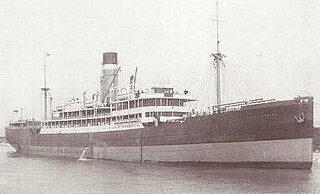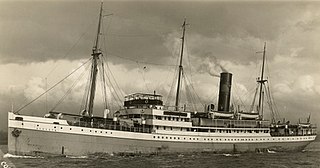
German submarine U-75 was a Type VIIB U-boat of Nazi Germany's Kriegsmarine during World War II. U-75 was moderately successful in her early career in the Battle of the Atlantic, but in autumn 1941 she was dispatched to the Mediterranean Sea with poor results, leading to the eventual destruction of the boat and her crew.

German submarine U-509 was a Type IXC U-boat of Nazi Germany's Kriegsmarine during World War II. The submarine was laid down on 1 November 1940 at the Deutsche Werft yard in Hamburg as yard number 305. She was launched on 19 August 1941, and commissioned on 4 November 1941 under the command of Korvettenkapitän Karl-Heinz Wolff.
Hai was a wolfpack of German U-boats that operated from 3 to 21 July 1942 in the Battle of the Atlantic during World War II. They attacked the Liverpool to Freetown, Sierra Leone convoy OS-33, sinking eight ships for a total of 61,125 gross register tons (GRT).
Vorwärts was a wolfpack of German U-boats that operated from 25 August to 26 September 1942, in the Battle of the Atlantic during World War II. They attacked several convoys, principally Convoy ON 127, sailing from Liverpool to New York, and sank fifteen ships for a total of 79,331 gross register tons (GRT), and damaged nine (81,141 GRT).

SS City of Venice was an intermediate ocean liner that was launched in 1924 in Northern Ireland for Ellerman Lines. In the Second World War she was a troop ship. In 1943 a U-boat sank her in the Mediterranean, killing 22 of the crew and troops aboard.
SS Assyrian was a cargo ship that was built in Hamburg for German owners in 1914, transferred to British owners in 1920 as war reparations and sunk by a U-boat in 1940. She was launched as MS Fritz, and when she changed owners in 1920 she was renamed MS Assyrian. She had been built as a motor ship but in 1925 she was converted to a steamship and became SS Assyrian.

SS Corinthic was a British cargo steamship. She was built on Teesside in 1924, sailed in a number of convoys in the Second World War, survived an overwhelming German attack on Convoy SC 7 October 1940, but was sunk by a German U-boat off West Africa in April 1941.

SS Soesterberg was a Dutch-owned cargo steamship that was built in Belgium in 1927 and sunk by a U-boat in 1940 in the Battle of the Atlantic.

SS Fiscus was a UK cargo steamship that was built in 1928, served in the Second World War and was sunk by a U-boat in 1940.
SS Marietta E was a British cargo ship completed by William Hamilton & Co in Port Glasgow on the Firth of Clyde in June 1940. She had a single 520 NHP triple-expansion steam engine built by David Rowan and Company of Glasgow, that drove a single screw. She had eight corrugated furnaces heating two 225 lbf/in2 single-ended boilers with a combined heating surface of 7,643 square feet (710 m2), plus one auxiliary boiler.
SS Empire Tower was a British 4,378 GRT cargo ship built in 1935 and sunk by enemy action in 1943.

SS Shuntien was a 3,059 GRT coastal passenger and cargo liner of the British-owned The China Navigation Company Ltd (CNC). She was built in Hong Kong in 1934 and sunk by enemy action in the Mediterranean Sea with great loss of life in 1941. A Royal Navy corvette rescued most of Shuntien's survivors, but a few hours later the corvette too was sunk and no-one survived.
SS Creekirk was a cargo steamship that was built in Scotland in 1912 and sunk with all hands by a German submarine in 1940. At her launch in 1912 she was named SS Mariston. In her 28-year career she was renamed SS Milcovul in 1913, SS Hyphaestos in 1933 and SS Creekirk in 1938.
SS Yoma was a British passenger liner that served as a troop ship in the Second World War. She was built in Scotland in 1928, and from then until 1940 Yoma ran a regular route between Glasgow in Scotland and Rangoon in Burma via Liverpool, Palma, Marseille and Egypt. She became a troop ship in 1941 and was sunk with great loss of life in the Mediterranean in 1943.

SS Oropesa was a British steam turbine ocean liner of the Pacific Steam Navigation Company (PSNC). She was built on Merseyside in 1920 and operated between Liverpool and South America. In 1941 the German submarine U-96 sank her in the Western Approaches, killing 106 people aboard.
SS Clan Macarthur was a British refrigerated cargo steamship. She was built for Cayzer, Irvine and Company's Clan Line Steamers Ltd as one of its Cameron-class steamships. She was launched in Greenock in 1936 and sunk in the Indian Ocean by enemy action in August 1943.

SS Avoceta was a British steam passenger liner. She was built in Dundee in 1923 and was sunk by enemy action in the North Atlantic in 1941. She belonged to Yeoward Line, which carried passengers and fruit between Liverpool, Lisbon, Madeira and the Canary Islands.
SS Mohamed Ali El-Kebir, formerly SS Teno, was one of a pair of steam turbine ocean liners built in Scotland in 1922 for the Chilean company CSAV. She and her sister ship Aconcagua ran between Valparaíso and New York via the Panama Canal until 1932, when CSAV was hit by the Great Depression and surrendered the two ships to the Scottish shipbuilder Lithgows to clear a debt.
SS Florian was an Ellerman Lines cargo steamship that was launched in 1939 and completed in 1940. A U-boat sank her with all hands in 1941 in the Battle of the Atlantic.
SS Hartlebury was a cargo steamship that was launched in Scotland in 1934 for J&C Harrison Ltd. A U-boat sank her in the Barents Sea in 1942 when Hartlebury was a member of the Arctic convoy Convoy PQ 17.








